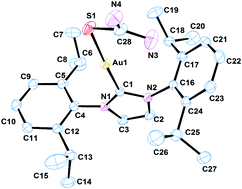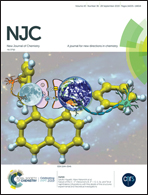Cytotoxic effects of gold(i) complexes against colon, cervical and osteo carcinoma cell lines: a mechanistic approach†
Abstract
Water-soluble gold(I) complexes, [Au(Ipr)(L)]PF6 where L = thiourea (Tu) 1 and N,N′-dimethylthiourea (Me2Tu) 2, were synthesized from the parent 1,3-bis(2,6-di-isopropylphenyl)imidazol-2-ylidenechloridogold(I) [(Ipr)AuCl] (0). The complexes (0–2) were fully characterized using elemental analysis (EA), FT-IR, 1H and 13C NMR spectroscopy. Single crystal X-ray diffraction analysis shows that both complexes have a near linear geometry. We investigated the in vitro cytotoxic activity of the complexes and cisplatin using an MTT assay against human osteosarcoma (MG-63), colon adenocarcinoma (HCT15), and cervical cancer (HeLa) cell lines. The IC50 values showed that the complexes 1 and 2 exhibit cytotoxicity higher than that of cisplatin against all cancer cell lines. The complex 2 exhibited cytotoxicity less than that of cisplatin against HeLa. The interaction of the complexes with amino acids was tested electrochemically in a phosphate buffer aqueous solution using cyclic voltammetry. Complex 1 interacted more with L-tryptophan than complex 2. The interaction of both complexes with L-tryptophan resulted in the reduction in peak height and peak current of L-tryptophan. Studying the expression levels of caspase-3 and caspase-9 genes provided insight into the cell death mechanism. The treatment of the HCT-15 and HeLa cells with complex 1 resulted in the induction of apoptosis and a significant up-regulation in the expression of both caspase-3 and 9. No significant deviation was noted in the expression of the MG-63 cells treated with complex 1.



 Please wait while we load your content...
Please wait while we load your content...